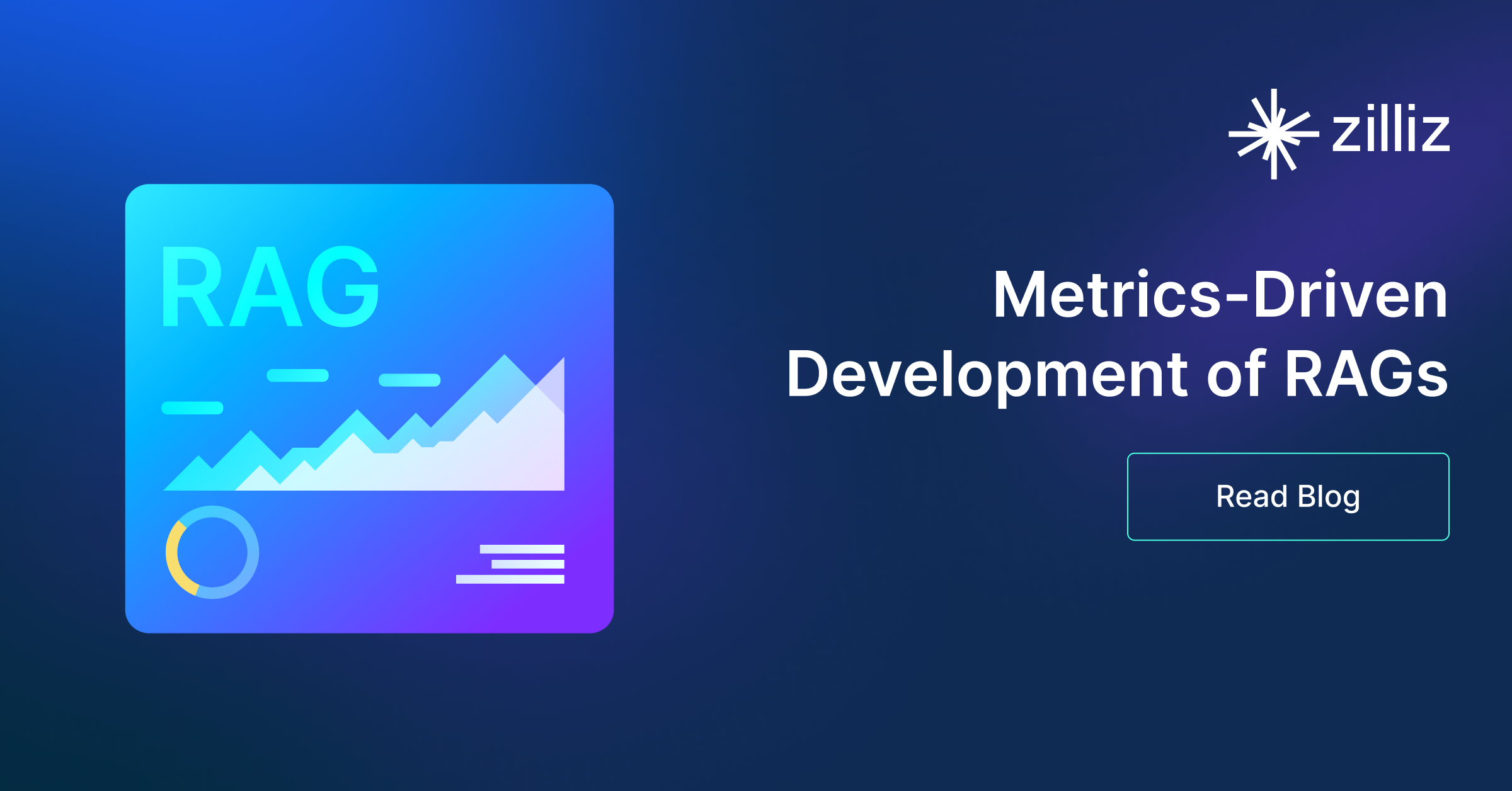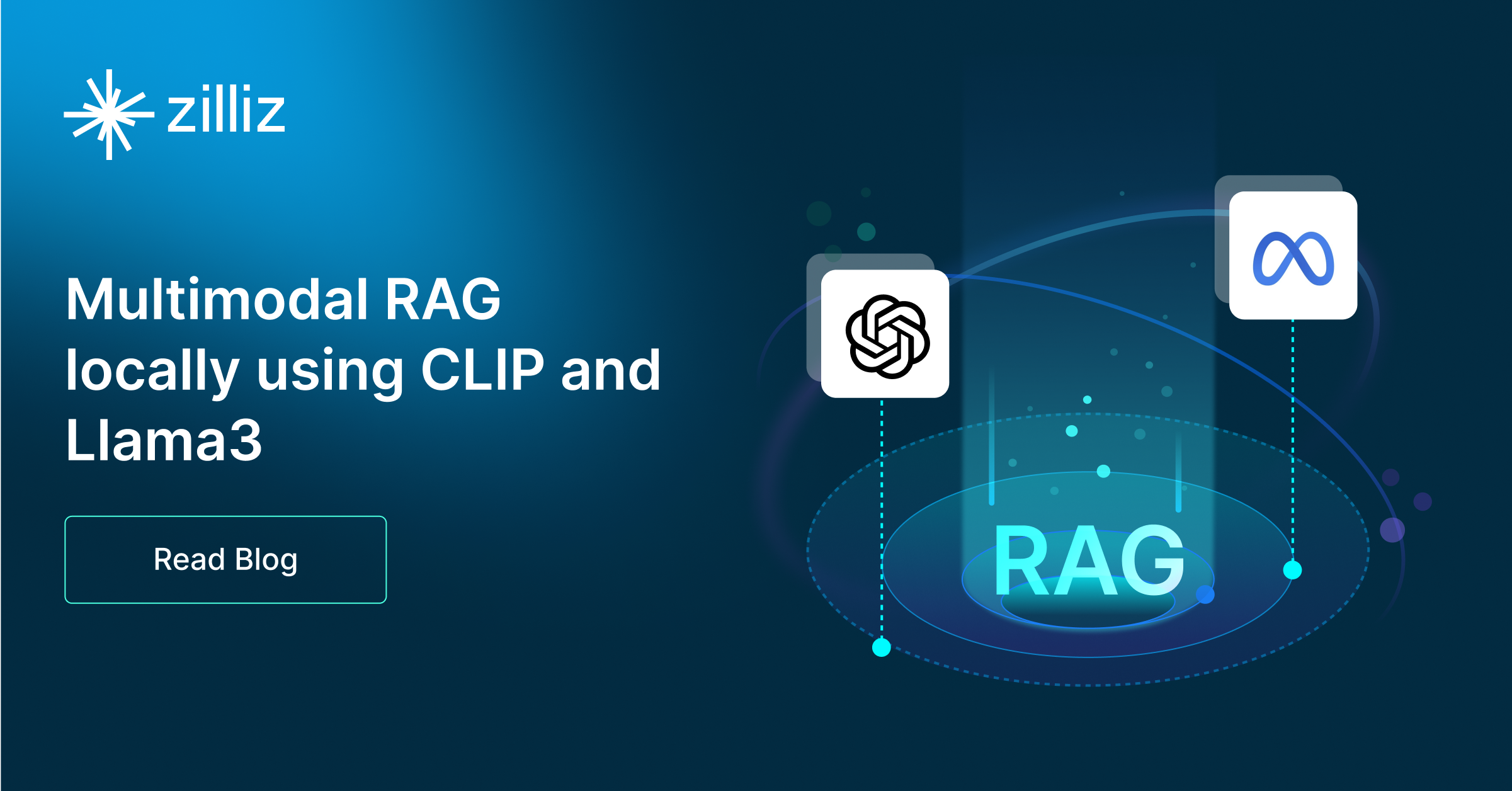Build RAG Chatbot with LangChain, Milvus, NVIDA Llama 3 70B Instruct, and OpenAI text-embedding-3-large
Introduction to RAG
Retrieval-Augmented Generation (RAG) is a game-changer for GenAI applications, especially in conversational AI. It combines the power of pre-trained large language models (LLMs) like OpenAI’s GPT with external knowledge sources stored in vector databases such as Milvus and Zilliz Cloud, allowing for more accurate, contextually relevant, and up-to-date response generation. A RAG pipeline usually consists of four basic components: a vector database, an embedding model, an LLM, and a framework.
Key Components We'll Use for This RAG Chatbot
This tutorial shows you how to build a simple RAG chatbot in Python using the following components:
- LangChain: An open-source framework that helps you orchestrate the interaction between LLMs, vector stores, embedding models, etc, making it easier to integrate a RAG pipeline.
- Milvus: An open-source vector database optimized to store, index, and search large-scale vector embeddings efficiently, perfect for use cases like RAG, semantic search, and recommender systems. If you hate to manage your own infrastructure, we recommend using Zilliz Cloud, which is a fully managed vector database service built on Milvus and offers a free tier supporting up to 1 million vectors.
- NVIDIA Llama 3 70B Instruct: This powerful model is designed for instruction-following tasks, leveraging its 70 billion parameters to deliver high-quality responses. It excels in generating detailed answers and engaging in complex dialogues, making it ideal for educational tools, customer support, and interactive applications that require nuanced understanding and guidance.
- text-embedding-3-large: OpenAI's text embedding model, generating embeddings with 1536 dimensions, designed for tasks like semantic search and similarity matching.
By the end of this tutorial, you’ll have a functional chatbot capable of answering questions based on a custom knowledge base.
Note: Since we may use proprietary models in our tutorials, make sure you have the required API key beforehand.
Step 1: Install and Set Up LangChain
%pip install --quiet --upgrade langchain-text-splitters langchain-community langgraph
Step 2: Install and Set Up NVIDA Llama 3 70B Instruct
pip install -qU "langchain-nvidia-ai-endpoints"
import getpass
import os
if not os.environ.get("NVIDIA_API_KEY"):
os.environ["NVIDIA_API_KEY"] = getpass.getpass("Enter API key for NVIDIA: ")
from langchain.chat_models import init_chat_model
llm = init_chat_model("meta/llama3-70b-instruct", model_provider="nvidia")
Step 3: Install and Set Up OpenAI text-embedding-3-large
pip install -qU langchain-openai
import getpass
import os
if not os.environ.get("OPENAI_API_KEY"):
os.environ["OPENAI_API_KEY"] = getpass.getpass("Enter API key for OpenAI: ")
from langchain_openai import OpenAIEmbeddings
embeddings = OpenAIEmbeddings(model="text-embedding-3-large")
Step 4: Install and Set Up Milvus
pip install -qU langchain-milvus
from langchain_milvus import Milvus
vector_store = Milvus(embedding_function=embeddings)
Step 5: Build a RAG Chatbot
Now that you’ve set up all components, let’s start to build a simple chatbot. We’ll use the Milvus introduction doc as a private knowledge base. You can replace it with your own dataset to customize your RAG chatbot.
import bs4
from langchain import hub
from langchain_community.document_loaders import WebBaseLoader
from langchain_core.documents import Document
from langchain_text_splitters import RecursiveCharacterTextSplitter
from langgraph.graph import START, StateGraph
from typing_extensions import List, TypedDict
# Load and chunk contents of the blog
loader = WebBaseLoader(
web_paths=("https://milvus.io/docs/overview.md",),
bs_kwargs=dict(
parse_only=bs4.SoupStrainer(
class_=("doc-style doc-post-content")
)
),
)
docs = loader.load()
text_splitter = RecursiveCharacterTextSplitter(chunk_size=1000, chunk_overlap=200)
all_splits = text_splitter.split_documents(docs)
# Index chunks
_ = vector_store.add_documents(documents=all_splits)
# Define prompt for question-answering
prompt = hub.pull("rlm/rag-prompt")
# Define state for application
class State(TypedDict):
question: str
context: List[Document]
answer: str
# Define application steps
def retrieve(state: State):
retrieved_docs = vector_store.similarity_search(state["question"])
return {"context": retrieved_docs}
def generate(state: State):
docs_content = "\n\n".join(doc.page_content for doc in state["context"])
messages = prompt.invoke({"question": state["question"], "context": docs_content})
response = llm.invoke(messages)
return {"answer": response.content}
# Compile application and test
graph_builder = StateGraph(State).add_sequence([retrieve, generate])
graph_builder.add_edge(START, "retrieve")
graph = graph_builder.compile()
Test the Chatbot
Yeah! You've built your own chatbot. Let's ask the chatbot a question.
response = graph.invoke({"question": "What data types does Milvus support?"})
print(response["answer"])
Example Output
Milvus supports various data types including sparse vectors, binary vectors, JSON, and arrays. Additionally, it handles common numerical and character types, making it versatile for different data modeling needs. This allows users to manage unstructured or multi-modal data efficiently.
Optimization Tips
As you build your RAG system, optimization is key to ensuring peak performance and efficiency. While setting up the components is an essential first step, fine-tuning each one will help you create a solution that works even better and scales seamlessly. In this section, we’ll share some practical tips for optimizing all these components, giving you the edge to build smarter, faster, and more responsive RAG applications.
LangChain optimization tips
To optimize LangChain, focus on minimizing redundant operations in your workflow by structuring your chains and agents efficiently. Use caching to avoid repeated computations, speeding up your system, and experiment with modular design to ensure that components like models or databases can be easily swapped out. This will provide both flexibility and efficiency, allowing you to quickly scale your system without unnecessary delays or complications.
Milvus optimization tips
Milvus serves as a highly efficient vector database, critical for retrieval tasks in a RAG system. To optimize its performance, ensure that indexes are properly built to balance speed and accuracy; consider utilizing HNSW (Hierarchical Navigable Small World) for efficient nearest neighbor search where response time is crucial. Partitioning data based on usage patterns can enhance query performance and reduce load times, enabling better scalability. Regularly monitor and adjust cache settings based on query frequency to avoid latency during data retrieval. Employ batch processing for vector insertions, which can minimize database lock contention and enhance overall throughput. Additionally, fine-tune the model parameters by experimenting with the dimensionality of the vectors; higher dimensions can improve retrieval accuracy but may increase search time, necessitating a balance tailored to your specific use case and hardware infrastructure.
NVIDIA Llama 3 70B Instruct optimization tips
NVIDIA Llama 3 70B Instruct is a high-precision model ideal for RAG applications requiring in-depth reasoning and analysis. Optimize retrieval by using hierarchical document ranking to filter only the most relevant passages, reducing unnecessary token consumption. Structure prompts with a clear separation between user queries, retrieved context, and system instructions for optimal performance. Keep temperature between 0.1 and 0.3 for factual consistency while fine-tuning top-k and top-p for better control over response diversity. Leverage NVIDIA’s TensorRT-LLM and optimized inference stacks to accelerate model execution and reduce latency. Use batching strategies to improve throughput for high-volume workloads. If deploying multiple models, assign Llama 3 70B to handle complex queries requiring deep contextual understanding while reserving lighter models for faster, low-complexity tasks.
OpenAI text-embedding-3-large optimization tips
OpenAI text-embedding-3-large is a high-capacity embedding model designed for precise and rich semantic representation, making it ideal for RAG systems with complex document retrieval needs. Optimize efficiency by preprocessing and normalizing text to reduce noise before embedding generation. Use dimensionality reduction techniques, such as PCA, if storage or computational limits become a concern. When querying, leverage HNSW-based approximate nearest neighbor (ANN) search to accelerate retrieval while maintaining accuracy. Batch process embedding requests to reduce latency and optimize resource utilization. Implement re-ranking models to further refine top results based on query context. Regularly update the embedding store with newly ingested data to maintain retrieval relevance.
By implementing these tips across your components, you'll be able to enhance the performance and functionality of your RAG system, ensuring it’s optimized for both speed and accuracy. Keep testing, iterating, and refining your setup to stay ahead in the ever-evolving world of AI development.
RAG Cost Calculator: A Free Tool to Calculate Your Cost in Seconds
Estimating the cost of a Retrieval-Augmented Generation (RAG) pipeline involves analyzing expenses across vector storage, compute resources, and API usage. Key cost drivers include vector database queries, embedding generation, and LLM inference.
RAG Cost Calculator is a free tool that quickly estimates the cost of building a RAG pipeline, including chunking, embedding, vector storage/search, and LLM generation. It also helps you identify cost-saving opportunities and achieve up to 10x cost reduction on vector databases with the serverless option.
 Calculate your RAG cost
Calculate your RAG cost
What Have You Learned?
What have you learned? Throughout this tutorial, you've taken significant steps into the exciting world of Retrieval-Augmented Generation (RAG) systems! By integrating LangChain as your robust framework, you learned how it seamlessly connects all the building blocks into a cohesive and efficient application. This cohesive structure allows your system to perform effortlessly, giving you the best performance right out of the gate.
Next, you explored how Milvus, the powerful vector database, supercharges your application. With its lightning-fast search capabilities, you can easily retrieve relevant information in the blink of an eye, making your RAG system not just functional but super responsive. You've also delved into NVIDIA's Llama 3 70B Instruct model, discovering how it powers your system’s conversational intelligence. This LLM elevates user interactions, ensuring they’re not just informative but engaging and natural.
And let’s not forget the embedding model! You’ve seen how it crafts rich semantic representations, providing context and depth to every interaction. Along the way, we shared some optimization tips to enhance your performance and introduced a handy cost calculator to budget your projects wisely.
Now, the entire landscape of possibilities lies before you. So, what are you waiting for? Dive in, start building, and let your creativity flow as you craft, optimize, and innovate your very own RAG applications. The future is bright, and it's all in your hands!
Further Resources
🌟 In addition to this RAG tutorial, unleash your full potential with these incredible resources to level up your RAG skills.
- How to Build a Multimodal RAG | Documentation
- How to Enhance the Performance of Your RAG Pipeline
- Graph RAG with Milvus | Documentation
- How to Evaluate RAG Applications - Zilliz Learn
- Generative AI Resource Hub | Zilliz
We'd Love to Hear What You Think!
We’d love to hear your thoughts! 🌟 Leave your questions or comments below or join our vibrant Milvus Discord community to share your experiences, ask questions, or connect with thousands of AI enthusiasts. Your journey matters to us!
If you like this tutorial, show your support by giving our Milvus GitHub repo a star ⭐—it means the world to us and inspires us to keep creating! 💖
- Introduction to RAG
- Key Components We'll Use for This RAG Chatbot
- Step 1: Install and Set Up LangChain
- Step 2: Install and Set Up NVIDA Llama 3 70B Instruct
- Step 3: Install and Set Up OpenAI text-embedding-3-large
- Step 4: Install and Set Up Milvus
- Step 5: Build a RAG Chatbot
- Optimization Tips
- RAG Cost Calculator: A Free Tool to Calculate Your Cost in Seconds
- What Have You Learned?
- Further Resources
- We'd Love to Hear What You Think!
Content
Vector Database at Scale
Zilliz Cloud is a fully-managed vector database built for scale, perfect for your RAG apps.
Try Zilliz Cloud for Free


